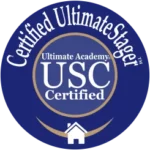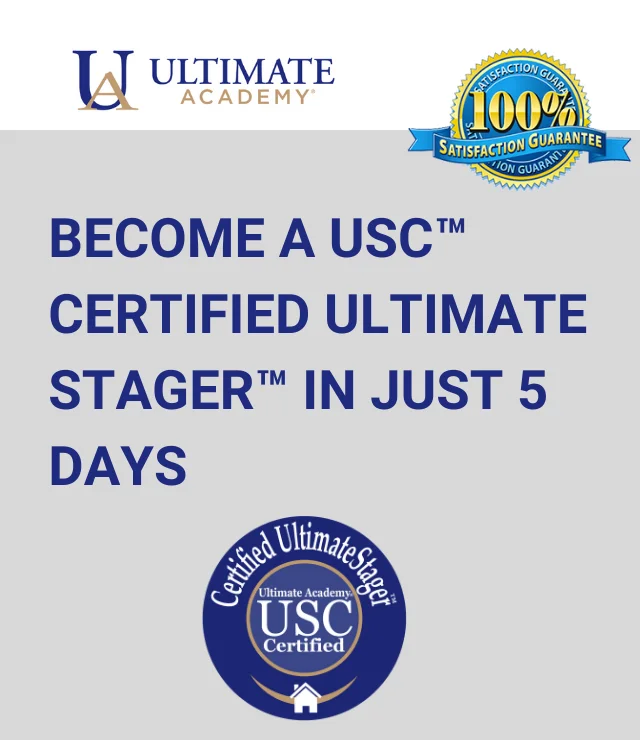How Do Home Stagers Get Clients?

This article tackles an important question: how do skilled home stagers find clients who need their services? Let’s look into various successful strategies to help with this. These strategies are about getting hands-on experience, creating an impressive portfolio, making connections with real estate professionals, and using a mix of online marketing and classic advertising.
How Do Home Stagers Get Business?
Here’s a strategic approach to enhance your prospects in the home staging industry:
- Pursue Professional Certification: Elevate your credibility and expertise through recognized home staging certifications. This step not only boosts your professional profile but also provides you with comprehensive knowledge and skills.
- Seek Experience: Gain practical experience in home staging. This could involve working on diverse projects to hone your skills and understanding of different styles and spaces.
- Develop a Compelling Portfolio: Create an impressive portfolio that showcases your best work. This visual representation of your abilities is a key tool in attracting potential clients.
- Network Within the Home Staging and Real Estate Industry: Establish connections with fellow home stagers and real estate professionals. Networking can open doors to new opportunities and collaborations.
- Leverage Online Marketing: Utilize digital platforms to market your services. This includes maintaining an active social media presence, crafting a professional website, and employing SEO strategies to reach a wider audience.
- Engage with in-Person Marketing Efforts: Participate in local events, host workshops, and use traditional advertising methods to make a direct impact. Personal interactions can leave lasting impressions.
- Focus on Relationship Marketing and Referral Programs: Build strong relationships with clients and real estate agents. Satisfied customers and industry connections can become valuable sources of referrals, helping you expand your client base.
- Create a Marketing Campaign Targeting Agents: Create a compelling marketing campaign to “win agents over.” Agents offer repeat business and, in some markets, the agent is the one paying for the staging. This campaign will include 7 to 8 touches, to win agents over, over time and will contain things like a script of a phone call, introductory email, follow-up email, newsletter, and social media activity (follows, likes, comments, shares and posting) across different platforms.
1. Pursue Professional Home Staging Certification
The role of a home stager extends beyond merely enhancing the aesthetics of homes. It encompasses a deep understanding of potential clients’ needs, staying abreast of current design trends, implementing effective marketing strategies, and adeptly navigating the local real estate market’s intricacies.
Earning a certification in home staging not only lends credibility but also demonstrates a commitment to excellence in this highly competitive field. For clients weighing their options among various staging professionals, recognized credentials can significantly tip the scale in your favor.
Engaging in formal education equips aspiring home stagers with essential skills and knowledge. It’s not just about learning the fundamentals of staging; it’s also about understanding how to effectively market your services and position yourself as a key player in your local real estate community. Courses often cover a range of topics, from colour theory and space planning to client relations and business management. This holistic approach ensures that you’re well-prepared to meet the diverse needs of your clients and can handle various staging scenarios with professionalism and creativity.
2. Seek Experience
Gaining experience by practicing techniques learned during coursework is invaluable; it prepares individuals for the challenges they might face while working with actual clients or tackling complex projects. Having hands-on practice under their belt before starting work professionally increases confidence levels tremendously.
Earned certifications serve as proof-of-knowledge-and-experience badges, providing reassurance to future clients about the high-quality service they can expect. They represent a great deal of hard work, learning, and dedication to mastering an art that significantly impacts people’s lives by helping them sell their homes at the best possible list price.
Start with Friends and Family Homes
Taking on projects at no cost might seem counterintuitive when trying to start a business, but offering free consultations or even full-scale stagings can be incredibly beneficial. It gives you exposure and lets you demonstrate your abilities firsthand without any risk to the homeowner.
Leverage Home Staging Certification Practice Opportunities
Apart from casual opportunities around family and friends’ circles, formal training programs often offer practical application opportunities too. These platforms provide budding professionals with chance encounters with real-life scenarios.
Certification courses emphasize practical application alongside theoretical knowledge – they help in sharpening a critical eye needed for assessing properties before transforming them into appealing prospects for buyers. Ultimate Academy®’s home staging program, for instance, emphasizes this type of fieldwork as part of their curriculum. Ultimate Academy® tasks learners with staging a room in their home or their family and friends’ homes. Learners are responsible for assessing the space, filling out a consultation report, and communicating the recommendations/suggestions with the homeowners. A discussion is then facilitated on the activity, allowing everyone to learn from and with each other.
3. Develop a Compelling Portfolio
As a home stager, showcasing your skills and style through an impressive portfolio is essential. It serves as a powerful marketing tool that attracts potential clients to your staging business.
A well-crafted portfolio speaks volumes about the quality of work you deliver. It’s akin to entering an exhibition home – it allows prospective clients a glimpse of what they can anticipate from your services. Remember, pictures paint thousands of words.
Your portfolio should reflect not only the spaces you’ve transformed, but also how those transformations have impacted sales for real estate agents or homeowners. This will highlight the value proposition that comes with hiring you as their staging expert.
Incorporating before-and-after photos is another effective strategy in creating compelling portfolios. These images provide concrete evidence of how effective staging design enhances curb appeal and boosts list price attractiveness, thereby enticing more potential buyers.
Tips on Building Your Home Staging Portfolio
The first step towards building an eye-catching portfolio starts with gaining hands-on experience through practical staging projects such as volunteering to stage homes for friends or family members free-of-charge initially.
This approach helps build trust among prospective clients while simultaneously helping to expand your mailing list. This list may include email addresses obtained during these early interactions with people who showed interest in your service’s pricing structure or overall presentation techniques.
Furthermore, maintaining regular updates on social media channels could be seen as having a digital extension of your physical portfolio – one easily accessible by anyone around the globe. Be sure to showcase diverse styles accommodating various client preferences, ranging from contemporary minimalistic designs to classic vintage themes, depending on the property types at hand.
4. Network within the Home Staging and Real Estate Industry
Building a network within the home staging industry is crucial for unlocking significant business opportunities. Networking with other professionals not only opens up avenues for referrals and collaboration but also enriches your understanding of the industry.
Building Relationships with Other Home Stagers
Fostering relationships with fellow home stagers is mutually beneficial. It involves sharing insights about different staging jobs, discussing challenges faced in the field, and collectively brainstorming solutions. Such interactions are not solely about competing; they are more about collaboration and collective growth. Networking within your peer group can lead to the sharing of resources, referrals, and even joint ventures in larger projects.
Joining professional associations, such as the Real Estate Staging Association (RESA), is an excellent way to start building these connections. Being a member of such organizations offers a platform to meet peers, exchange experiences, and learn from seasoned professionals. Additionally, these associations often host events, workshops, and conferences, which are valuable for staying updated with industry trends and meeting potential clients.
Connecting with Real Estate Agents
Expanding your network to include real estate agents is equally important. Agents constantly seek skilled home stagers to enhance their property listings, making them more appealing to potential buyers. By collaborating with real estate agents, you can significantly influence the speed and price at which homes are sold, which is a crucial selling point for agents.
To foster these relationships, actively reach out to local real estate offices, participate in real estate events, and consider offering informational sessions or workshops for agents to demonstrate the value of home staging. This not only positions you as a knowledgeable expert in the field but also establishes a direct line of communication with those who can directly benefit from your services.
The Long-Term Value of Networking
Remember, building a professional network is a gradual process that requires patience and consistent effort. Over time, your network becomes an invaluable asset, serving as your primary marketing tool. Word-of-mouth referrals from trusted colleagues and satisfied clients often lead to new business opportunities more effectively than traditional advertising.
Actively building and nurturing professional relationships within the home staging and real estate communities can significantly elevate your business. It’s about creating a supportive ecosystem where everyone benefits from shared knowledge, resources, and opportunities.

5. Leverage Online Marketing
In the dynamic world of home staging, the advent of online marketing tools has opened up new avenues for reaching potential clients. Developing a robust online presence is a key strategy for home stagers in today’s digital era.
Harnessing Social Media Channels
Social media platforms provide an excellent showcase for your projects and a direct line of communication with prospective clients. Consistently posting high-quality content on platforms like Instagram or TikTok not only establishes your credibility but also helps in attracting and retaining a client base. Tailored social media strategies for home stagers are essential to effectively utilize these platforms. This involves curating a mix of engaging content, from showcasing your latest projects to sharing home staging tips and industry trends.
Crafting Your Professional Website
Your website acts as the digital storefront of your business, often forming the first impression for potential clients. It’s imperative to ensure that your website is well-designed, user-friendly, and mobile-responsive. A clear display of your past staging projects can give visitors a tangible sense of your expertise and style. High-quality images, detailed service descriptions, and easy navigation are key elements that can enhance the user experience.
Tips For Effective Online Marketing:
Create Engaging Content: Utilize before-and-after photos, client testimonials, and insightful blog posts to showcase your expertise and the transformative power of your staging skills.
Leverage SEO Techniques: Incorporate relevant keywords and phrases like ‘home staging’, ‘interior design’, and ‘staging expert’ into your website’s content to improve its visibility on search engines.
Maintain Regular Interaction: Engage actively with your audience by promptly responding to comments or queries. This not only builds trust but also fosters a sense of community around your brand.
Expanding Your Digital Footprint:
Email Marketing: Develop an email newsletter to share updates, tips, and special offers. This can be an effective way to keep your services top-of-mind for past and potential clients. Email newsletters provide updates about new offerings or exciting deals that may pique the interest of existing clients while attracting new ones at the same time. To build this mailing list, consider offering something valuable – like a free consultation – in exchange for visitors’ email addresses on your website or blog posts.
Online Advertising: Consider using targeted ads on platforms like Google and Facebook to reach a broader audience. Tailoring your ads to specific demographics and interests can increase their effectiveness.
Integrating various online marketing strategies can significantly broaden your reach compared to traditional marketing methods alone. Building successful online relationships takes consistent effort and time, but the potential to grow your client base and establish your brand in the digital space is substantial.
6. Engage with In-Person Marketing Efforts
Establishing yourself as a home stager involves more than just online presence; in-person marketing is equally essential. Direct interactions provide unique opportunities to create lasting impressions and forge strong relationships.
Attending Local Networking Events
A pivotal aspect of a successful marketing strategy is participating in local networking events. These gatherings are perfect settings to connect with potential clients, realtors, and other business professionals. Direct engagement with these individuals allows you to demonstrate your home staging expertise and articulate its significant impact on selling properties more quickly and potentially at a higher price.
The power of face-to-face communication cannot be underestimated. People are more likely to remember and form a connection with someone they’ve met in person compared to an online interaction. Therefore, seize every opportunity that comes your way, from home buyers/sellers seminars to local business gatherings and industry conferences. These events not only increase your visibility but also allow you to stay informed about local market trends and needs.
Utilizing Traditional Advertising Methods
In addition to networking and workshops, traditional advertising methods like local newspaper ads, flyers, and community bulletin board postings can be effective. These methods can complement your digital efforts, especially in reaching audiences who may not be as active online.
Combining in-person marketing efforts with your online strategies creates a well-rounded approach. It enhances your visibility, strengthens your reputation, and opens up more avenues for business growth in the competitive field of home staging.
7. Focus on Relationship Marketing and Referral Programs
The cornerstone of a thriving home staging business lies in effective relationship marketing. Cultivating strong connections with clients, real estate agents, and fellow home stagers is vital for expanding your client base.
In the real estate market, trust is paramount. Demonstrating your expertise and ability to enhance property sales through professional staging significantly increases the likelihood of referrals. This trust-based relationship marketing is the foundation of impactful referral programs.
Organizations offer invaluable networking opportunities among members, potentially leading to industry referrals. However, it’s important to extend your reach beyond this immediate network. Explore connections in related fields such as interior design or participate in local real estate events to tap into a broader range of potential customers.
Social Media as a Relationship-Building Tool
In today’s digital age, active engagement on social media platforms is a critical component of relationship marketing. Regularly sharing engaging content related to home staging on platforms like Instagram or Facebook keeps you at the forefront of your clients’ minds, whether they are current or prospective.
Engaging with your audience, such as responding to comments and messages, fosters trust and rapport. This level of interaction is essential for cultivating word-of-mouth recommendations, one of the most effective forms of marketing in the home staging industry.
Incentive Programs: Reward Loyalty and Encourage Referrals
Never underestimate the power of word-of-mouth promotion. Incentive programs that appreciate and reward clients for their referrals can significantly attract new business. These programs also help in solidifying your existing customer relationships, as clients feel valued and recognized for their contributions to your business growth.
A blend of relationship marketing, referral incentives, and a strong presence on digital platforms can remarkably enhance the visibility and success of your home staging business in a competitive market. By leveraging both traditional and innovative marketing strategies, you create a multifaceted approach that caters to a diverse client base and builds lasting business relationships.
8. Create a Marketing Campaign Targeting Agents
Creating a compelling marketing campaign to win over real estate agents, who are key players in the home staging industry, involves a multi-touch approach. The goal is to establish a relationship of trust and professionalism. Here’s a detailed plan that spans 7 to 8 touches:
1. Introductory Email:
Purpose: Introduce your staging services, highlighting unique selling points (USPs).
Content: Brief overview of your services, past success stories, and a call-to-action (CTA) for a phone conversation or meeting.
Timing: Send this as the first point of contact.
2. Personalized Phone Call:
Script: Start with a brief introduction, mention how your services can benefit the agent specifically (referencing local market trends), and propose a face-to-face meeting.
Objective: Set up a meeting to discuss potential collaboration.
Timing: A few days after the email, giving them time to review it.
3. Follow-up Email:
Purpose: Recap the phone conversation and reaffirm the value you bring.
Content: A brief thank-you note, key points discussed on the call, and next steps.
Timing: Send within 24 hours of the phone call.
4. Newsletter Subscription Invitation:
Objective: Keep agents informed about your work and industry trends.
Content: Share insights, staging tips, success stories, and market trends.
Method: Include a subscription link in the follow-up email or during the meeting.
5. Social Media Engagement:
Platforms: Focus on LinkedIn, Instagram, and Facebook.
Activities: Follow agents’ profiles, like and comment on their posts, share relevant content, and post regular updates about your work.
Objective: Stay top-of-mind and build a professional relationship online.
6. Personalized Direct Mail:
Content: Send a postcard or brochure showcasing recent staging projects with testimonials.
Timing: A few weeks after the initial contact to keep the momentum.
7. Exclusive Offer or Event Invitation:
Purpose: Provide value and build a stronger connection.
Content: Offer a special discount for first-time collaboration or invite them to an exclusive event like a home staging workshop.
Timing: Send after establishing initial interest and engagement.
8. Final Follow-Up Call:
Objective: Seal the deal.
Script: Discuss any pending questions, reiterate the value proposition, and propose a collaboration.
Timing: After they’ve had a chance to absorb all the information.
Throughout this campaign, it’s crucial to maintain consistency in your messaging and branding. Tailor your communication to reflect understanding of the real estate market and the specific needs of each agent. The ultimate goal is to build a relationship that positions you as a go-to expert in home staging, leading to repeat business and referrals.
Conclusion
Establishing a successful home staging business involves a blend of practical experience, professional networking, effective online and offline marketing, and delivering high-quality work that resonates with potential buyers. Building strong relationships within the real estate industry, showcasing a diverse and captivating portfolio, and implementing flexible pricing strategies are key to attracting and retaining clients.
By focusing on these core elements, home stagers can create a thriving business that not only enhances property appeal but also drives profitability in the dynamic real estate market.

Learn About our Home Staging Certification

Similar Articles
FAQs About How Home Stagers Acquire Clients
To generate leads for staging, you can start by building strong connections with real estate agents and brokers, as they are often in direct contact with sellers who need staging services. Utilize online marketing strategies like maintaining an active presence on social media platforms, engaging with your audience, and optimizing your website for search engines (SEO) to increase your visibility. A captivating and diverse portfolio showcasing your best work can also attract potential clients. Additionally, consider participating in local real estate events and home shows, and asking satisfied clients for referrals.
The profitability of a home staging business can vary widely based on factors such as location, demand, and the stager’s expertise. According to Realtor.com, home stagers may charge between $150 to $600 per room, or a percentage of the home’s sale price. The profitability also depends on how efficiently the business is run, the cost of staging materials, and the ability to maintain a steady flow of projects. High-quality work that effectively enhances a property’s appeal can lead to higher demand for services, thus increasing profitability.
To become a successful home stager, start by gaining practical experience, which could include volunteering to stage homes for friends or family. Earning certifications in home staging can enhance your credibility and skills. Develop an impressive portfolio to showcase your work and style. Networking with real estate professionals and other stagers can lead to more opportunities. Effective marketing, both online through social media and a professional website, and offline through local events and word-of-mouth, is essential. Consistently delivering high-quality work and maintaining good client relationships also contribute to long-term success.
When staging a home, avoid over-personalizing the space, as this can make it difficult for potential buyers to envision themselves living there. Conversely, leaving rooms too empty can make them feel uninviting. Ensure that every part of the home, including less visible areas, is thoroughly cleaned, as buyers tend to scrutinize every detail. Don’t underestimate the importance of curb appeal, as the exterior of the home is the first thing buyers see. Striking the right balance between stylish and neutral is key.
Charging for home staging varies based on whether you’re staging an occupied or vacant property. For occupied properties you might charge per consultation or offer package deals. For vacant properties, consider pricing strategies such as per room, per square foot, flat rate, or package deals. Additionally, offering different tiers of service, like a verbal consultation at a lower cost and a more detailed written report at a higher price, can provide options to suit various client needs and budgets. It’s important to set prices that reflect your expertise, costs, and the local market rates.













